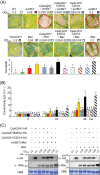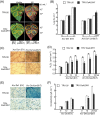Pepper aldehyde dehydrogenase CaALDH1 interacts with Xanthomonas effector AvrBsT and promotes effector-triggered cell death and defence responses
- PMID: 25873668
- PMCID: PMC4449550
- DOI: 10.1093/jxb/erv147
Pepper aldehyde dehydrogenase CaALDH1 interacts with Xanthomonas effector AvrBsT and promotes effector-triggered cell death and defence responses
Abstract
Xanthomonas type III effector AvrBsT induces hypersensitive cell death and defence responses in pepper (Capsicum annuum) and Nicotiana benthamiana. Little is known about the host factors that interact with AvrBsT. Here, we identified pepper aldehyde dehydrogenase 1 (CaALDH1) as an AvrBsT-interacting protein. Bimolecular fluorescence complementation and co-immunoprecipitation assays confirmed the interaction between CaALDH1 and AvrBsT in planta. CaALDH1:smGFP fluorescence was detected in the cytoplasm. CaALDH1 expression in pepper was rapidly and strongly induced by avirulent Xanthomonas campestris pv. vesicatoria (Xcv) Ds1 (avrBsT) infection. Transient co-expression of CaALDH1 with avrBsT significantly enhanced avrBsT-triggered cell death in N. benthamiana leaves. Aldehyde dehydrogenase activity was higher in leaves transiently expressing CaALDH1, suggesting that CaALDH1 acts as a cell death enhancer, independently of AvrBsT. CaALDH1 silencing disrupted phenolic compound accumulation, H2O2 production, defence response gene expression, and cell death during avirulent Xcv Ds1 (avrBsT) infection. Transgenic Arabidopsis thaliana overexpressing CaALDH1 exhibited enhanced defence response to Pseudomonas syringae pv. tomato and Hyaloperonospora arabidopsidis infection. These results indicate that cytoplasmic CaALDH1 interacts with AvrBsT and promotes plant cell death and defence responses.
Keywords: Aldehyde dehydrogenase; Xanthomonas campestris pv. vesicatoria.; cell death; effector AvrBsT; pepper; plant defence.
© The Author 2015. Published by Oxford University Press on behalf of the Society for Experimental Biology.
Figures











Similar articles
-
Molecular functions of Xanthomonas type III effector AvrBsT and its plant interactors in cell death and defense signaling.Planta. 2017 Feb;245(2):237-253. doi: 10.1007/s00425-016-2628-x. Epub 2016 Dec 7. Planta. 2017. PMID: 27928637 Review.
-
The Capsicum annuum class IV chitinase ChitIV interacts with receptor-like cytoplasmic protein kinase PIK1 to accelerate PIK1-triggered cell death and defence responses.J Exp Bot. 2015 Apr;66(7):1987-99. doi: 10.1093/jxb/erv001. Epub 2015 Feb 17. J Exp Bot. 2015. PMID: 25694549 Free PMC article.
-
Pepper heat shock protein 70a interacts with the type III effector AvrBsT and triggers plant cell death and immunity.Plant Physiol. 2015 Feb;167(2):307-22. doi: 10.1104/pp.114.253898. Epub 2014 Dec 9. Plant Physiol. 2015. PMID: 25491184 Free PMC article.
-
Overexpression of Xanthomonas campestris pv. vesicatoria effector AvrBsT in Arabidopsis triggers plant cell death, disease and defense responses.Planta. 2012 Oct;236(4):1191-204. doi: 10.1007/s00425-012-1672-4. Epub 2012 Jun 8. Planta. 2012. PMID: 22678032
-
Functional roles of the pepper leucine-rich repeat protein and its interactions with pathogenesis-related and hypersensitive-induced proteins in plant cell death and immunity.Planta. 2017 Sep;246(3):351-364. doi: 10.1007/s00425-017-2709-5. Epub 2017 May 15. Planta. 2017. PMID: 28508261 Review.
Cited by
-
Sugarcane transcriptome analysis in response to infection caused by Acidovorax avenae subsp. avenae.PLoS One. 2016 Dec 9;11(12):e0166473. doi: 10.1371/journal.pone.0166473. eCollection 2016. PLoS One. 2016. PMID: 27936012 Free PMC article.
-
Genome-wide characterization of the aldehyde dehydrogenase gene superfamily in soybean and its potential role in drought stress response.BMC Genomics. 2017 Jul 7;18(1):518. doi: 10.1186/s12864-017-3908-y. BMC Genomics. 2017. PMID: 28687067 Free PMC article.
-
Zucchini Plants Alter Gene Expression and Emission of (E)-β-Caryophyllene Following Aphis gossypii Infestation.Front Plant Sci. 2021 Jan 8;11:592603. doi: 10.3389/fpls.2020.592603. eCollection 2020. Front Plant Sci. 2021. PMID: 33488643 Free PMC article.
-
Construction of a kiwifruit yeast two-hybrid cDNA library to identify host targets of the Pseudomonas syringae pv. actinidiae effector AvrPto5.BMC Res Notes. 2019 Jan 28;12(1):63. doi: 10.1186/s13104-019-4102-x. BMC Res Notes. 2019. PMID: 30691538 Free PMC article.
-
Molecular functions of Xanthomonas type III effector AvrBsT and its plant interactors in cell death and defense signaling.Planta. 2017 Feb;245(2):237-253. doi: 10.1007/s00425-016-2628-x. Epub 2016 Dec 7. Planta. 2017. PMID: 27928637 Review.
References
-
- Chen TH, Murata N. 2002. Enhancement of tolerance of abiotic stress by metabolic engineering of betaines and other compatible solutes. Current Opinion in Plant Biology 5, 250–257. - PubMed
-
- Chen XB, Zeng Q, Wood AJ. 2002. The stress-responsive Tortula ruralis gene ALDH21A1 describes a novel eukaryotic aldehyde dehydrogenase protein family. Journal of Plant Physiology 159, 677–684.
Publication types
MeSH terms
Substances
LinkOut - more resources
Full Text Sources
Other Literature Sources

